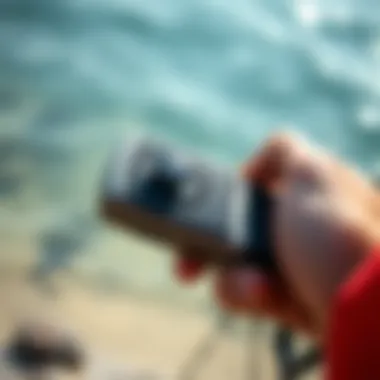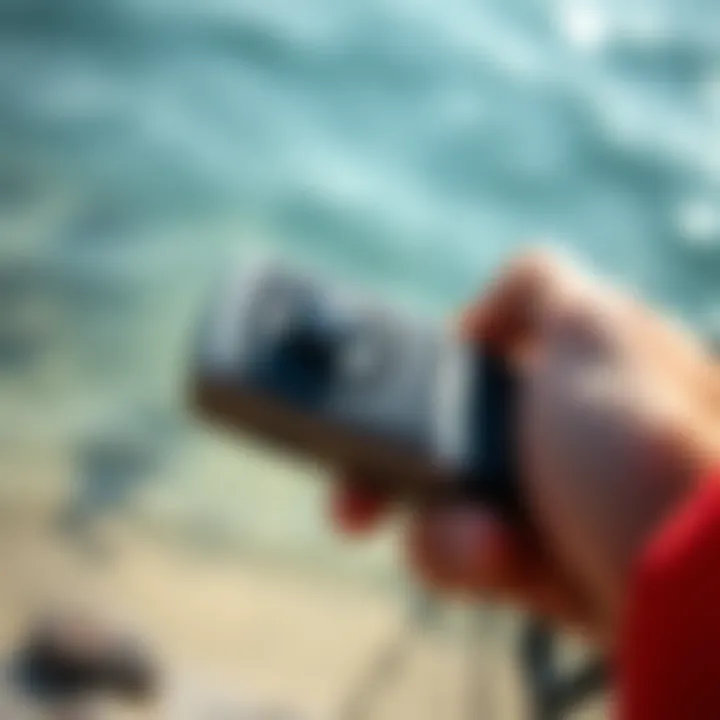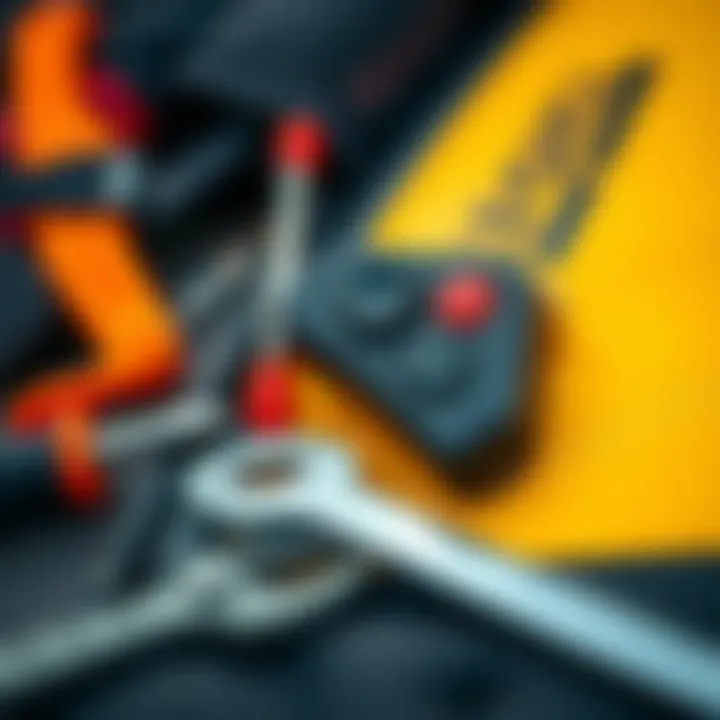Understanding the Efoil Remote: A Complete Guide


Intro
The rise of electric hydrofoiling has transformed the world of water sports, creating new avenues for excitement and adventure on the water. At the heart of this exhilarating experience lies the efoil remote, a pivotal tool that connects riders with their hydrofoils. This guide takes you through every aspect of the efoil remote—from its intricate design to its essential features—ensuring that aspiring and seasoned kiteboarders alike can harness this technology for an unparalleled riding experience.
Understanding the efoil remote is not just about knowing how to operate it. It's about enhancing your safety and enjoyment while riding. In the sections that follow, we will shine a light on the fundamental functions of these remotes, explore the technological innovations behind them, and provide practical advice to ensure you have a top-notch experience whether you’re zipping along the shoreline or cutting through still waters.
Gear Insights
Latest Gear Reviews
Before selecting an efoil remote, it's crucial to weigh your options. The market is brimming with various remotes tailored to different riding styles and levels of expertise. Two notable ones are the Lift eFoil Remote and the Fliteboard Remote. These remotes stand out due to their ergonomic design and precise control settings. For instance, the Lift remote features a color touchscreen that offers real-time speed and battery life updates, allowing riders to adjust swiftly while in motion. Contrast that with the Fliteboard remote, which is known for its simplicity and reliability. These elements enhance user experience by providing essential information at a glance.
When going for rides, I’ve found that having a dependable remote makes all the difference. If you’re a beginner, start with something that feels good in your hand and isn’t overloaded with features. As your skills develop, you might find value in more advanced remotes that provide performance analytics.
Essential Gear for Beginners
For newcomers looking to navigate the waters confidently, understanding the essentials goes beyond just the remote. Here’s a short rundown of necessary items:
- Proper Life Jacket: Being buoyant isn’t just about style; it’s about safety.
- Wetsuit: Keeps you warm and comfortable, enabling longer sessions on the water.
- Board Shorts/Swimwear: If wearing a wetsuit isn’t your cup of tea, good fitting swimwear can also do just fine.
- Efoil Safety Leash: This can keep your board close should you take a tumble, an integral part of your setup.
Investing in quality gear can save you a lot of hassle. It’s clear that beginners should familiarize themselves with each piece of equipment, including their remotes.
Techniques and Tips
Advanced Tricks and Techniques
As your confidence builds, you may want to dig into some advanced tricks. For instance, learning how to initiate a jump involves subtle weight shifts combined with momentary throttle adjustments on your remote. The trick lies in timing—don’t rush it. It’s always smart to practice in calmer waters before trying to impress anyone with your moves.
Safety Practices for Kiteboarders
Safety should never take a backseat. Here’s a brief checklist to ensure you stay safe while efoiling:
- Know Your Surroundings: Familiarize yourself with the water currents, and avoid riding near crowded areas.
- Check Equipment Regularly: Make it a habit to inspect your remote and other gear before each ride.
- Use a Buddy System: It's always safer to go out with a friend or fellow rider.
"If you think safety is expensive, try an accident," a valued reminder for anyone diving into adventure sports.
By emphasizing safety alongside skill, we can ensure that the thrill of riding an efoil doesn't come with unnecessary risks. The purpose of this guide is to illuminate the path for both novice and advanced kiteboarders, and to ensure that everyone enjoys this incredible sport responsibly.
Whether you’re chasing waves or gliding over calm lakes, mastering the efoil remote is integral to a fulfilling experience. Stay tuned for more insights on how to optimize every aspect of your ride.
Prelims to Efoil Technology
Efoiling represents a remarkable fusion of cutting-edge technology and thrilling recreational pursuits. This section shines a light on the core concept of efoiling, elucidating its significance in modern watersports. Efoiling not only transforms the way riders interact with water but also enhances their overall experience, tapping into the thrill of effortlessly gliding above the waves on an electric hydrofoil.
The importance of understanding efoil technology stems from several aspects: first, riders gain insights into the mechanics that make efoiling possible, which can enhance their riding technique. Second, awareness of the equipment enables users to navigate the waters safely, especially as they learn to adapt to different environmental conditions. Lastly, an informed rider can appreciate the blend of innovation and skill that embodies the sport.
Definition of Efoiling
Efoiling is the practice of riding on a hydrofoil board that is lifted above the water's surface by an electric motor. The board sits on a submerged foil, which generates lift as the rider gains speed. This allows for a unique sensation of flying above the water, liberated from the drag and resistance typically experienced while surfing or paddleboarding.
One could say it’s an electrifying way of cruising, offering an escape from the bounds of traditional watersports. Transforming mere waves into a canvas for performance, efoiling has gained momentum as equipment becomes more accessible, and enthusiasts share their experiences across social platforms.
How Efoils Work
The mechanics of efoils blend simplicity and sophistication, ensuring that riders can enjoy a seamless experience. The efoil system mainly consists of a board, a hydrofoil, an electric motor, a battery, and a remote control.
- The Board: It’s generally made from lightweight materials like carbon fiber or fiberglass to promote agility and ease of handling.
- The Hydrofoil: This is the key component that lifts the board above water when sufficient speed is reached. The design may vary, with different shapes catering to specific riding styles or conditions.
- Electric Motor: Positioned at the rear of the foil, this motor is responsible for propelling the board forward. Riders can adjust speed using the remote control, offering a tailored experience suited for beginners or advanced users.
- Battery: The power source for the motor, it's often rechargeable. Battery life can impact riding duration, with enthusiasm driving innovations toward longer-lasting options.
- Remote Control: The link between rider and board. It allows for instantaneous feedback and control over the speed, which can make the difference between a smooth ride and a jarring experience when learning the ropes.
In a nutshell, efoiling harnesses electric propulsion to deliver an exhilarating fusion of speed, freedom, and a unique connection to water that riders across the globe cherish. Getting familiar with how efoils operate sets the stage for understanding the remotes that control them, ultimately contributing to a richer overall experience on the water.
Overview of Efoil Remote Controllers
In the realm of efoiling, the significance of remote controllers cannot be overstated. These devices act as the vital link between rider and machine, facilitating navigation, speed control, and overall performance. A rider's mastery of their efoil largely hinges upon the effectiveness and responsiveness of the remote. Therefore, understanding the various components of efoil remotes and their operational frameworks is crucial for anyone looking to enhance their riding experience.
Purpose of the Efoil Remote
The purpose of the efoil remote extends beyond merely switching the device on or off. At its heart, the remote is an essential tool that allows riders to fine-tune their ride, controlling not just speed but also stability and maneuverability. For instance, imagine carving gracefully through the water; a responsive remote ensures fluid transitions and precision turns. Moreover, different remotes come with features tailored to meet various skill levels and riding styles. From beginner paddling to advanced tricks, the right remote enhances learning and enables riders to push their boundaries in a safer manner.


It’s also important to recognize how the remote’s functionality integrates with safety features. Many advanced models include emergency shutoff options that immediately cut power to the motor if a rider falls or the remote slips from their grasp. This feature underscores the remote's role in not just enhancing performance but ensuring safety while riding.
Design and Ergonomics
The design and ergonomics of an efoil remote are pivotal in shaping rider experience. A well-designed remote feels comfortable in hand, allowing for prolonged use without fatigue. Consider, for instance, the grip texture; it should cater to wet conditions while still providing adequate control. Additionally, remotes come in various shapes and sizes, and finding one that fits snugly is essential.
Color and button layout also play a role in user-friendliness. Bright colors can aid visibility in bright sunlight, while buttons that are tactfully placed allow for intuitive operation without diverting attention from the water. Engaging with an efoil remote should be a seamless process—one where a mere flick of the thumb can adjust speed or direction without a second thought.
"The right remote makes all the difference, transforming an ordinary experience into an extraordinary one."
Overall, the combination of purpose and design within efoil remotes raises the bar for riding adventures. As the technology continues to evolve, understanding these aspects becomes vital for any serious rider aiming for an optimized and safe experience on the water. This knowledge not only contributes to better performance but also helps in establishing a deep-rooted connection between rider and the hydraulic marvel they command.
Key Features of Efoil Remotes
Efoil remotes have become an essential tool for anyone engaging in efoiling. Their design and functionality go far beyond just being a means to control the electric hydrofoil. Understanding the key features of these remotes can significantly improve one’s efoiling experience, especially for those who are looking to push their limits on the water. The features define how a rider interacts with the equipment, ensuring not just performance, but also safety and durability.
Control Input Mechanics
Control input mechanics refer to how users interact with the remote to manage their ride. Typically, these remotes feature a throttle control, often a trigger or a dial, which adjusts the power output to the motor. Riders need responsive and intuitive controls to fine-tune their speed and movement. This is especially important during challenging riding conditions.
For instance, a remote that allows for gradual acceleration can help beginners maintain control, while advanced riders might prefer remotes that offer rapid responsiveness.
- Ergonomic Design: The design should fit comfortably in hand, allowing for easy adjustments while on the move.
- Feedback Mechanisms: Many modern remotes also incorporate haptic feedback, giving the rider tangible responses based on input, making the interaction more immersive.
Battery Life and Management
Battery life is another critical consideration for efoil remotes. Riders depend on having enough power for extended sessions without the risk of losing their support mid-ride. Most remotes come with rechargeable lithium-ion batteries that vary in capacity. Proper management includes understanding battery indicators displayed on the remote. These often show both the current charge level and the estimated remaining ride time.
- Smart Battery Management: Many remotes are equipped with smart battery management systems that help optimize power consumption based on the rider's usage patterns.
- Battery Replacement: Knowing how to easily replace or recharge the battery is crucial. Riders should choose remotes with user-friendly battery compartments to minimize downtime.
Durability and Waterproofing
The water is the realm for efoils, and the remotes must withstand it. Durability and waterproofing are paramount features. An efoil remote is often exposed to splashes, drops, and occasionally the residue of saltwater. Therefore, a quality remote should offer a robust build that resists corrosion. Look for remotes labeled with an IP rating, indicating their degree of water resistance.
A good practice is to inspect seals or gaskets periodically to ensure they are intact.
Important Note: Choosing a remote with a higher waterproof rating can prevent damage in case of unintentional submersion. Consider options designed to float, in case of accidental drops.
Types of Efoil Remotes Available
In the ever-evolving world of efoiling, understanding the different types of remotes is paramount for both novice and seasoned riders. The choice of an efoil remote can drastically alter the riding experience, affecting control, responsiveness, and overall enjoyment on the water. When considering the types of remotes available, it’s vital to weigh the benefits of wireless versus wired options as well as the enhanced functionalities offered by smart remotes.
Wireless vs. Wired Remotes
The debate over wireless and wired remotes often comes down to personal preference and specific riding conditions. Wireless remotes are lauded for their convenience, allowing riders to maneuver freely without being encumbered by cords. This physical freedom can be pivotal when performing tricks or navigating the waves, as there's no risk of getting caught in a tangle.
On the flip side, wired remotes do come with their own set of advantages. Primarily, they provide a more stable connection, reducing latency between the remote and the efoil itself. This can be crucial for experienced riders who require instant feedback to execute precise movements.
Key Considerations for Each Type:
- Wireless Remotes
- Wired Remotes
- Pros:
- Cons:
- Freedom of movement; no cords to manage.
- Often lighter and more portable.
- Battery dependency; requires regular charging.
- Potential signal interference in crowded areas.
- Pros:
- Cons:
- Consistent connection; less potential for lag.
- Often designed with robust materials, adding to durability.
- Limited range of movement; can be cumbersome.
- Risk of cord damage over time, necessitating care in use.
Ultimately, the decision lies in balancing convenience against reliability. Riders should consider not just their riding style but also where they plan to efoil. In crowded waters, for example, a wired remote may offer more peace of mind, while open spaces could showcase the freedom provided by wireless options.
Smart Remotes with Advanced Features
The emergence of smart remotes marks a significant leap in efoil technology. These remotes come with advanced features, transforming the ride into a more interactive and informative experience for the rider. Many smart remotes boast LCD displays that provide real-time stats such as speed, remaining battery life, and even distance traveled.
This data can be crucial for riders seeking to maximize their time on the water or those aiming to improve their riding skills. Some remotes also offer customizable settings, allowing users to adjust acceleration sensitivity or set speed limits to enhance safety, particularly for beginners.


Noteworthy Features of Smart Remotes:
- Real-Time Data Display:
- Customizable Settings:
- Integrative Technologies:
- Speed, battery life, and other metrics available at a glance.
- Tailor control sensitivity and response to match riding conditions.
- Potential to sync with smartphone apps for tracking and sharing experiences.
As technology continues to evolve, the possibilities for smart remotes seem boundless, opening doors for even more advanced features like GPS tracking and connectivity with other devices on the water.
The right efoil remote can be the difference between a good ride and a great one, tailoring the experience to meet the demands of the rider.
Interpreting Remote Readings and Feedback
When it comes to efoiling, understanding the remote readings and feedback is crucial. These interactions provide vital information that can influence a rider's performance and safety on the water. Misinterpreting these signals can lead to a breakdown in communication between the rider and the board, which can be dangerous, especially for newcomers. Therefore, a grasp of these readings not only enhances overall experience but also builds confidence in handling the efoil.
Understanding Displays
LCD displays on efoil remotes serve as the main interface for riders to gauge their status while riding. They offer real-time information such as battery life, speed, and sometimes even depth. It's like peering into the heart of your machine—flashing numbers and symbols that communicate everything you need to know at a glance.
Having an understanding of the display's layout is essential. For instance, a low battery indicator might appear as a blinking icon, alerting the rider to return to shore before running out of power completely. Imagine riding smoothly, feeling the wind in your hair, and suddenly your board loses power—devastating, right? Keeping an eye on that battery display can make all the difference.
In addition, speed readings can help riders tame their excitement. While it's fun to push boundaries, knowing when you're reaching max speed allows for safer riding. Arm yourself with knowledge of these indicators.
"The ultimate gauge of an adventure lies in how well you read the signals around you."
Signal Strength Indicators
Signal strength indicators are another critical element on efoil remotes. They assure you of a stable connection between the remote and the board. If, for instance, you start noticing a drop in signal, it could herald impending issues. Understanding how these indicators work means you can act preemptively—whether it’s finding a clearer path or addressing potential interference from surrounding objects.
The signal strength typically varies from high to low, with color-coding providing a quick reference. A green light might indicate a strong signal, while a red light could scream for your attention, suggesting you need to maneuver towards better reception. This little detail can be the difference between a smooth ride and a sudden stop. Knowing these signals can make every trip safer and more enjoyable.
In summary, interpreting remote readings and feedback is not merely about reading numbers; it’s about developing an intrinsic understanding of the nuances that come with the experience. Paying attention to details displayed on the LCD and recognizing the importance of signal strength can transform the experience from good to great, while ensuring safety and enjoyment on the waves.
User Experience and Operational Considerations
When it comes to navigating the water on an efoil, having a seamless user experience is paramount. This spans from the very moment you unbox your remote, to how it feels in your hand as you glide over waves. Each interaction can significantly impact how enjoyable your session is and how safe you feel while riding.
Initial Setup and Pairing
The first step is critical - setting up and pairing your remote with the efoil. This process often involves charging the remote fully and ensuring that both devices are ready to communicate. Most remotes will have a pairing mode that can be activated, which lets the board and remote sync up without hassle.
Here's a more detailed look at this process:
- Charge Your Devices: Always start with fully charged batteries to avoid interruptions.
- Activate Pairing Mode: Whether by a button press or a specific sequence, opening the pairing mode on the remote is your gateway to connection.
- Follow on-screen Prompts: Often, remotes have screens that guide you through pairing, with visuals that simplify the procedure.
- Test the Connection: Tug on your board gently after pairing to check responsiveness. If it reacts, you’re good to go!
Getting the initial setup right not only saves you time on the water but also ensures that you stay focused on the ride ahead rather than fiddling with tech.
Adjusting to Different Riding Conditions
Once you’re set up, adjusting your riding behavior to variable conditions becomes essential. This is where the remote’s capabilities come into play, enabling you to fine-tune your experience based on various factors like wind, waves, and personal comfort levels.
Key Adjustments:
- Speed Control: Depending on the wind or current, adjust the speed settings on your remote. Higher speeds might be thrilling but can be tricky in blustery conditions.
- Response Settings: Some advanced remotes offer adjustable throttle sensitivity. Lowering this can make for smoother take-offs and a more controlled ride in choppy waters.
- Mode Switching: Many remotes have mode settings that can optimize for novice or advanced experiences. Switching to a beginner mode when necessary opens the door for safer practice.
"Adjusting your efoil remote settings to environmental factors can turn a good ride into a great ride."
Having a good grasp on how to dial in your controls to match the riding environment not only enhances safety but also elevates your overall experience on the water. The right adjustments can transform a windy, blustery day into an exhilarating adventure or turn a calm afternoon into a more spirited outing without losing stability.
In essence, understanding the user experience and the operational considerations surrounding your efoil remote is vital for any rider, especially for kiteboarders and other adventure-seekers. With proper setup and adjustments, one can ensure that the focus remains on enjoying the thrill of riding rather than worrying about the tech. Taking these steps can significantly elevate your water-bound escapades.
Safety Precautions When Using Efoil Remotes
Using efoil remotes is not just about having fun on the water; it's about doing so responsibly and safely. With the increasing popularity of efoiling, understanding the safety protocols associated with using these remotes is essential, especially for kiteboarders, instructors, and enthusiasts. A small oversight can lead to accidents that could have been easily prevented with awareness and precaution. In this section, we’ll break down vital safety measures that should never be overlooked when using an efoil remote.
Emergency Shutoff Features
One of the standout elements of efoil remote controllers is their emergency shutoff feature. This function is designed to quickly disable the propulsion system in case things go south. Imagine you're riding smoothly, and suddenly the controls become unresponsive, or you find yourself too close to another rider or an object.
With a simple clap of a button — or even a trigger mechanism on some models — riders can instantly halt their board. This rapid intervention is critical; it operates like a lifeline in precarious situations. For instance, if you inadvertently tip over and find yourself in the water, activating this feature can stop the efoil from propelling towards you, reducing the risk of injury.


"When it comes to safety, it's better to be safe than sorry. Having an emergency shutoff isn’t just a luxury—it’s a necessity."
Best Practices for Safe Riding
To truly enjoy your time on an efoil, adhering to best practices for safe riding is paramount. Here’s a handy guide:
- Pre-Ride Inspections: Always give your equipment a once-over before hitting the water. Check the remote battery levels, functionality of the safety features, and ensure your efoil is in good condition.
- Know Your Surroundings: Being aware of the environment is important. Look out for other watercraft, swimmers, and potential hazards in the water. Always maintain a safe distance from others to avoid collisions.
- Wear Protective Gear: While an efoil may provide thrilling experiences, it also poses risks. Wearing a proper life vest, helmet, and possibly even impact protection can greatly reduce the chances of injury in case of falls or collisions.
- Start Slow: New to efoiling? Take it easy at the start. Familiarize yourself with the speed and handling of your board before attempting any tricks or high-speed maneuvers.
- Monitor Weather and Water Conditions: Before heading out, understand what the weather and water conditions are like. High winds, rough waves, or sudden changes in weather can spell trouble. Close observation of local forecasts makes a difference.
Maintenance and Troubleshooting
When it comes to efoil remotes, maintenance and troubleshooting are key components that cannot be overlooked. A well-maintained remote not only ensures a smoother riding experience but also enhances longevity and reliability. The last thing you want is to be out on the water and find your remote malfunctioning, so understanding this aspect is vital for both safety and performance.
Cleaning and Care Guidelines
Keeping your efoil remote clean is essential for optimal functionality. Water, salt, and dirt can accumulate and potentially interfere with the performance of the remote. Here are some cleaning guidelines to keep in mind:
- Regular Wipe-Downs: After each use, take a damp cloth and give your remote a good wipe-down. Pay close attention to the buttons and crevices where dirt tends to get trapped.
- Avoid Harsh Chemicals: While you might be tempted to use heavy-duty cleaners, stick to mild soap mixed with water. Harsh solvents can degrade plastic and rubber components, which might result in unexpected issues.
- Dry Thoroughly: Always ensure that your remote is completely dry before storing it. Moisture left behind can breed mold or corrosion, especially in sensitive electronic components.
- Periodic Deep Cleaning: Every once in a while, take time to disassemble your remote, if possible, and clean the interior components gently. This helps in preventing dust build-up that might affect the operational efficacy.
Common Issues and Solutions
No matter how careful you are, issues can arise with efoil remotes. Understanding common problems and their solutions can save you a lot of time and headaches down the road.
- Signal Drop: One of the most frequent complaints is a sudden loss of signal.
- Unresponsive Buttons: Another common issue is when the buttons seem unresponsive.
- Battery Issues: If the remote dies unexpectedly, you may have battery or connectivity issues.
- Solution: Ensure that your remote's battery is adequately charged. Sometimes, being out of range can also cause this issue; check your distance from the efoil.
- Solution: This could be dirt or moisture interfering, so a good cleaning may resolve it. If the problem persists, look into possible water ingress. You may need to let the remote dry for a day.
- Solution: Always store your remote in a dry place at room temperature. Additionally, regular checks on battery terminals can help you catch any corrosion before it becomes problematic.
Keeping your efoil remote in top shape is not just about maintenance; it’s about ensuring every ride is safe and enjoyable. Treat your gear with care, and it will reward you with consistently thrilling experiences out on the water.
By following these guidelines for maintenance and troubleshooting, you can ensure your efoil remote remains an effective and reliable tool for your adventures. Proper care not only extends the lifespan of the hardware but also boosts your overall enjoyment as you tackle the open waters.
Future Developments in Efoil Technology
As the world of efoiling continuously evolves, keeping abreast of future developments in efoil technology becomes paramount for enthusiasts and professionals alike. Understanding these advancements does not only provide insight into the direction of the industry but also informs riders about upgrades that could enhance their riding experience. The ongoing quest for improved performance, efficiency, and user experience drives innovation in the realm of efoil remotes and systems.
Emerging Innovations in Remote Technology
In recent years, we've seen a wave of innovations surfacing in efoil remote technology. These advancements can significantly improve the user experience. Some important trends include:
- Enhanced Connectivity: New remotes often feature integrated Bluetooth or Wi-Fi, allowing for seamless real-time data transmission. This means riders can receive live feedback about their performance, speed, battery life, and other crucial metrics directly on the remote.
- User-Centric Design: Companies are prioritizing ergonomics and usability more than ever, leading to more comfortable remotes that fit naturally in the rider's hand, even in wet conditions. Improved grips and button placements cater to various hand sizes, making operation smoother.
- Customizable Settings: Riders can now personalize their riding experience through adjustable settings. For instance, the power output can sometimes be tailored according to individual skill levels, creating a more user-friendly atmosphere.
"It’s not just about riding the wave anymore; it’s about riding smartly and safely. Our tech is now part of the ride itself."
Integrating AI in Efoil Controls
Artificial intelligence is carving a niche in efoil technology, introducing transformative elements that were once mere fantasies. The integration of AI in efoil controls is set to revolutionize how riders interact with their equipment. Below are some key features that demonstrate the implications of AI in this field:
- Predictive Control: By employing machine learning algorithms, future remotes might anticipate rider intentions based on their previous patterns and preferences. This anticipation can lead to smoother rides as the electric propulsion adjusts automatically without needing manual input.
- Safety Enhancements: AI could also play a pivotal role in enhancing safety. For instance, should a rider lose balance, intelligent systems can automatically adjust speed or even cut power, significantly reducing the risk of accidents.
- Data Analytics: Integrated AI can analyze vast amounts of riding data over time, providing insights into performance metrics. Riders could get tailored recommendations for improvements based on their riding habits, curated by the remote itself.
For those who dive deep into tech analysis, AI's potential in enhancing the user interface and overall experience in efoils is undeniable, bridging the gap between human skill and machine precision.
As the technology continues to mature, keeping an eye on these developments will inform riders, improve safety, and enhance the overall enjoyment of efoiling. This progressive trajectory not only signifies better gadgets but also closer ties between technology and the thrill of riding.
Culmination
In the realm of efoiling, the remote is far more than just a tool; it's a lifeline that connects the rider with the electric hydrofoil. The efoil remote’s design, functionality, and safety features have evolved considerably, making it a pivotal part of the experience on the water.
Rather than simply facilitating communication between the rider and the board, it embodies the technological advancements that drive this sport forward. As we navigate through the waves of innovation, understanding the intricacies of the remote becomes essential for any enthusiast.
Recap of Key Points
- Purpose and Functionality: The remote isn't merely a control device; it’s crafted for an optimal user experience. A proper understanding can directly impact performance and safety.
- Types of Remotes: Recognizing the differences between wireless and wired remotes, as well as smart remotes, is crucial for choosing the right tool for one's riding style.
- Safety Features: Knowing about the emergency shutoff features and best practices can help prevent mishaps, ensuring a safer ride.
- Maintenance: Regular cleaning and taking care of the remote can extend its lifespan and ensure smooth operation.
The Role of Technology in Enhancing the Efoil Experience
Technological advancements in efoil remotes play a significant role in improving the overall experience for riders. The integration of smart features and intuitive designs means that users can focus on the ride rather than fiddling with controls. The incorporation of LCD displays for real-time feedback and signal strength indicators has transformed the riding experience, allowing for a more responsive and informed journey on the water.
Looking ahead, we see the potential for even greater implementations of technology, such as AI integration, which could further enhance responsiveness and adaptability during varying water conditions. Riders have access to features that keep them informed and engaged, making the efoiling experience not only more exhilarating but also far safer.
In summary, as technology continues to innovate, the efoil remote remains a central piece in creating a seamless bond between the rider and the thrill of the ride. Being well-acquainted with its complexities is not just for the hobbyist; it’s for anyone looking to truly maximize their experience and ensure they’re riding with confidence and safety.















